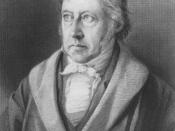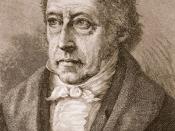Section CV
Analysis of Symbolic art
This section starts with Hegel explaining how, when the Idea of the divine caused Art- Symbolic Art to be specific, due to the Idea being undeveloped and indefinite, results in Symbolic Art being merely an effort to understand and transfer the mental concept of the Idea into a true to life representation, to basically try to transfer the Idea from the realm of the Mind into the realm of the world. Symbolic Art is the effort and striving of the Idea for expression. It is "rather a mere search after plastic portrayal". It can be concluded therefore that Hegel didn't believe that Symbolic Art even partially succeeded in its aim of representation.
It could be argued that for example the Egyptian would have been amply satisfied with their version of the Ideal, representation of their concept of the Idea of the Divine could have been sufficient through the use of animal characteristics.
Their level of thinking and interpretation was at a level whereby symbolic Art fulfilled the representation adequately i.e. their Mind filtered the shapes and sensuous matter of Symbolic Art, causing contemplation and understanding of the Idea, resulting in even slight comprehension of the Absolute Spirit.
Although by our more developed standards we can suggest that the Idea is in fact restricted and belittled by trying to access it through animal imagery, but even in this modern day and age the weird and stupendous shapes of Symbolic Art still exist, for example the representation of Hindu God and Godesses, such as Hanuman the Monkey God and Ganesh who is a half Elephant and half-human God. If Symbolic Art had been such a failure then it would have become obsolete after the perfection and the transcendent nature of Classical and Romantic Art.
The problem with Symbolic Art arises, according to Hegel because the "Idea has its outward shape external to itself", meaning that the Idea has not been conceived in a determinate enough way, so as to be able to indicate the form it is best represented in, which is in opposition to the conception of the Idea in the other forms of Art. For example in sculpture in the Classical period, the Idea was conceived along with a prior indication of the form best for it to be represented in - the Human figure.
Due to the lack of a specified form of representation, Natural sensuous matter are used in the struggle for expression in this stage.
There is not a reciprocal link between the Idea of the Divine and the form of representation, therefore "natural objects are thus left unaltered". This signifies the first of the three stages of Symbolic Art. An example from the artistic pantheism of the east best highlights the essence of this first stage. Hegel says how Egyptian art "charges even the meanest objects with Absolute import" meaning that there is only a one way link to the Divine which is to say that even a stone can be charged with the object of representing the Absolute, but there will not be divine intervention so to speak in regards to the medium used.
A disapproval of this simplistic and literal representation on Hegel's part is natural, because to start with, his idea of beauty was that only that which has been filtered through the mind is beautiful. His belief that the purpose of Art is to create a desire to ponder and contemplate about the Absolute Spirit also does not correlate with the simplistic representation mentioned above.
Going back to the first stage of Symbolic Art, according to Hegel the reason for which natural objects are left as they are is because they have an aspect to them which applies universally, it could be that the omniscience of nature would allow for everyone to interpret or see its import regardless of culture, upbringing and so on.
However due to the inadequacy of the media this aspect of nature can only be used to convey non-material qualities or abilities. Hegel uses the example of Lion = strength to convey the abstract quality of Lions. The example again raises a point of criticism. In Hegel's eyes this example simply proves the shallowness and literal essence of this first stage of Symbolic Art.
The inability to universalise and to actually convey general non-material qualities again shows how the form of representation is unsuited to the correspondence of the Idea of the Divine. When Hegel that " this abstractness of the relation brings to consciousness no less strongly the foreignness of the Idea to Natural Phenomena" it brings us to the second stage of Symbolic Art where, as opposed to the first stage where Natural objects are seen as enough to represent the Idea without changing them. They are given purpose by making their object, the representation of the Absolute Spirit.
In this stage there is a shift away from this, as it is no longer enough to just invest objects with the Idea but an attempt to mould the shapes into one that is sufficient in it's representation to basically "exalt the phenomenon to the level of the idea".
Due to the unsuitability of natural matter in the attempt to represent, this moulding or coercing of shapes results in a progressive search, this sensuous medium is used to try and express that which cannot be truly expressed in it. In this section Hegel tries to emphasise the sheer constriction and the frustration, which results in "unnatural shapes". The descriptive and very expressive imagery and language used tries to convey the bursting of shaping, "explode them into unnatural shapes". The sense of an effort to forcefully blossom is also suggested by Hegel's colourful descriptions of how the Idea "seethes and ferments" in the shapes, and how the Idea in its search "coerces nature with violence".
The emphasis on colourful and descriptive language here implies that Hegel is doing what he is describing, exploding shapes and coercing ideas. A hint that Hegel is suggesting that the reason for such distortion and expansion of shapes will compensate for the unsuitability of the medium through ingenuity, size, splendour and so on.
The search for an adequate shape seems to have gone into a trial and error phase where experimentation results, according to Hegel, in abnormal and in fact non- natural shapes.
The Idea throughout the various stages of Symbolic Art is abstract just as it is in the second stage of Symbolic Art, but the dilemma is that the forms and shapes used are fixed and "thoroughly determinate". In this second stage there has been an effort to somehow force the wrong piece of jigsaw into the final blank. The overall picture of the jigsaw, being the Idea.
The final part of Symbolic Art, due to the conflict between the Idea and the Ideal, one aspect being the conflict between the abstract and the determinate. Results in the realisation that the significance of the Idea of the Divine has to be exalted to a sublime level. In this final stage again there is a reversion to the first stage of Symbolic Art where objects and shapes are left as they are, but there is a difference though, because now the objects and shapes are no longer charged with the Absolute import meaning that the shapes an objects no longer hold a representative value. Now the Idea is seen as above nature and transcends and "is exalted far above every Earthly content".


